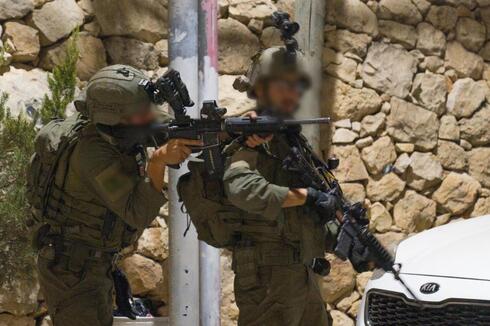By Yoav Zitun
Copyright ynetnews

Israeli forces are pushing deeper into Gaza City in a slow and methodical maneuver aimed at dismantling Hamas’ remaining military strongholds, two weeks into what the army has designated Operation Gideon’s Chariots II. Commanders say the strategy is to move cautiously, prioritizing troop safety over speed, while Hamas seeks to inflict heavy Israeli losses or seize a soldier to claim a propaganda victory. On Saturday, Golani reconnaissance troops ambushed Hamas terrorists near a tunnel shaft inside the city. A group of armed fighters emerged for close-quarters combat, but the Golani force struck first, stormed the position and killed most of them. One soldier was lightly wounded by grenade shrapnel in the encounter. Military officials described the clash as an example of the army’s doctrine of surprise and aggressive response preventing what could have been a deadly ambush. The operation is being directed under close supervision by Chief of Staff Lt. Gen. Eyal Zamir, who personally approves daily movements of brigade combat teams. Unlike the Gaza City incursion nearly two years ago, the army has avoided a rapid push toward Hamas command centers. Instead, units are advancing slowly, supported by heavy artillery and Israeli air force strikes ahead of every movement. Over the past two weeks, pilots and drone operators have conducted more than 200 airstrikes close to Israeli ground forces. Troops are establishing strongholds inside the city and advancing neighborhood by neighborhood in what officers describe as a “peeling” approach, removing Hamas defenses layer by layer. The army has not yet reached its primary objectives — the underground bases and the vast network of tunnels in central and western Gaza City — leaving Israel’s political leadership time to pursue hostage negotiations still under discussion. Daily clashes continue but many go unreported because they end without Israeli casualties. Hamas terrorists have detonated roadside bombs near tanks and armored carriers, fired RPGs and attempted sniper attacks from high-rise buildings. Engineering effort and long campaign The IDF is reinforcing positions inside Gaza City with defensive earthworks and new logistical hubs designed to sustain a long campaign. Military engineers are moving bulldozers and trucks laden with explosives to the front lines, preparing for what commanders describe as a systematic flattening of hundreds of buildings. The goal, they say, is to make it far more difficult for Hamas to rebuild tunnel networks beneath urban areas once the war ends. The army’s Technology and Logistics Directorate has nearly completed three large forward logistics centers for the 98th, 162nd and 36th divisions, which are leading the operation. Two other divisions — Gaza Division and the 99th — remain focused on defensive operations around the city and on maintaining the Nitzanim supply route to its south. The new bases are being built inside Gaza neighborhoods and along the coast, underscoring the expectation of a prolonged ground presence. They will provide daily maintenance for tanks, armored personnel carriers, engineering vehicles and weapons systems. Over time, the centers are expected to evolve into rest areas for soldiers, with showers, rest facilities, gear replacement and special meals for units rotating briefly out of combat. Fuel and water pipelines are being laid underground to the logistics sites, and the army is preparing to install a seawater desalination facility, as it did earlier in the war. Officials say plans to supply forces by sea have been shelved for now, though they are considering air-dropping heavy equipment using helicopters and large drones already operated by Atal, the army’s logistics technology unit. Flattening buildings, denying Hamas tunnels The army says the focus on engineering reflects lessons learned from the first Operation Gideon’s Chariots in Khan Younis earlier this year, when paratroopers alone flattened more than 2,100 buildings suspected of sheltering Hamas tunnels. That tactic, officers say, is being repeated in Gaza City to ensure Hamas cannot easily reconstruct underground networks in residential areas to which civilians are expected to return. Southern Gaza supply lines In southern Gaza, the army is reinforcing two key supply routes that cut through Khan Younis — Morag and Magen Oz — which were once seen as potential bargaining chips for a hostage release deal. Instead of exposed forward positions along the roads, the IDF is now building permanent fortified posts deeper in the area, intended to provide greater security and comfort for soldiers. The strategy mirrors changes made on other critical routes such as the Philadelphi Corridor, along Gaza’s 14-kilometer border with Egypt’s Sinai, and the Nitzanim axis, half of which remains in Israeli control while the other half is open for Palestinian civilians moving south. The army says roughly 800,000 residents have already left Gaza City, but fighting is expected to continue even if 200,000 to 300,000 remain. A decisive stage of the campaign is expected when Israel orders forces to advance on Hamas’ central strongholds in Gaza City. When that happens, the 99th Division is expected to seal off the Nitzanim corridor, which still allows civilians to move southward along the coast. Israeli assessments say Hamas commander Izz al-Din Haddad, who leads the group’s Gaza City brigade, is aiming to stage a mass-casualty attack or capture a soldier to project an image of victory even as many of his operatives retreat south. Another flashpoint will be the Shifa Hospital compound, Gaza’s main medical facility, which Israel has deliberately not entered. The site continues to operate, though officials believe Hamas is using it again for military purposes. Commanders expect the group to exploit any Israeli move there for propaganda purposes, and for now no decision has been made to storm the compound. Netanyahu loudspeaker dispute The military also faced political pressure over Prime Minister Benjamin Netanyahu’s demand that loudspeakers be set up in Gaza to broadcast his speech to the UN General Assembly on Friday. Netanyahu argued the broadcast was an influence operation directed at Palestinians in Gaza and possibly the Israeli hostages held there. Senior commanders considered the request inappropriate but, after Netanyahu’s military secretary Maj. Gen. Roman Gofman issued the order in writing, the Southern Command moved the loudspeakers several kilometers inside Gaza to ensure the speech could actually be heard. Soldiers involved said they were required to film the equipment during the broadcast, raising speculation the footage could later appear in Netanyahu’s election campaign, which begins formally in less than a year. West Bank escalation fears In the West Bank, Israel is preparing for possible escalation rather than annexation, despite demands by Finance Minister Bezalel Smotrich for unilateral moves that U.S. President Donald Trump has already rejected. Security officials advised Israel’s political leadership to lower its profile on annexation during the Jewish High Holidays, when threats of terror attacks rise. Central Command is building a new fire-control center in Jerusalem that will coordinate airstrikes and, in extreme cases, artillery strikes across the West Bank and along the Jordanian border. The center is modeled on those already operating in Northern and Southern Command for Lebanon and Gaza. Until about two years ago, Israel avoided airstrikes in the West Bank to prevent comparisons with the heavy bombing of the second intifada. But in the months before Oct. 7, the air force struck hundreds of times there, mainly against armed cells preparing attacks. The new center will include dozens of officers from the air force, artillery, intelligence and operations branches. “This is a historic day marking the laying of the cornerstone for the fire-control center in Central Command,” said Lt. Col. A., the command’s fire support chief. “Within a year and a half it will be operational, meeting an urgent need for both security and wartime scenarios in the sector.”



